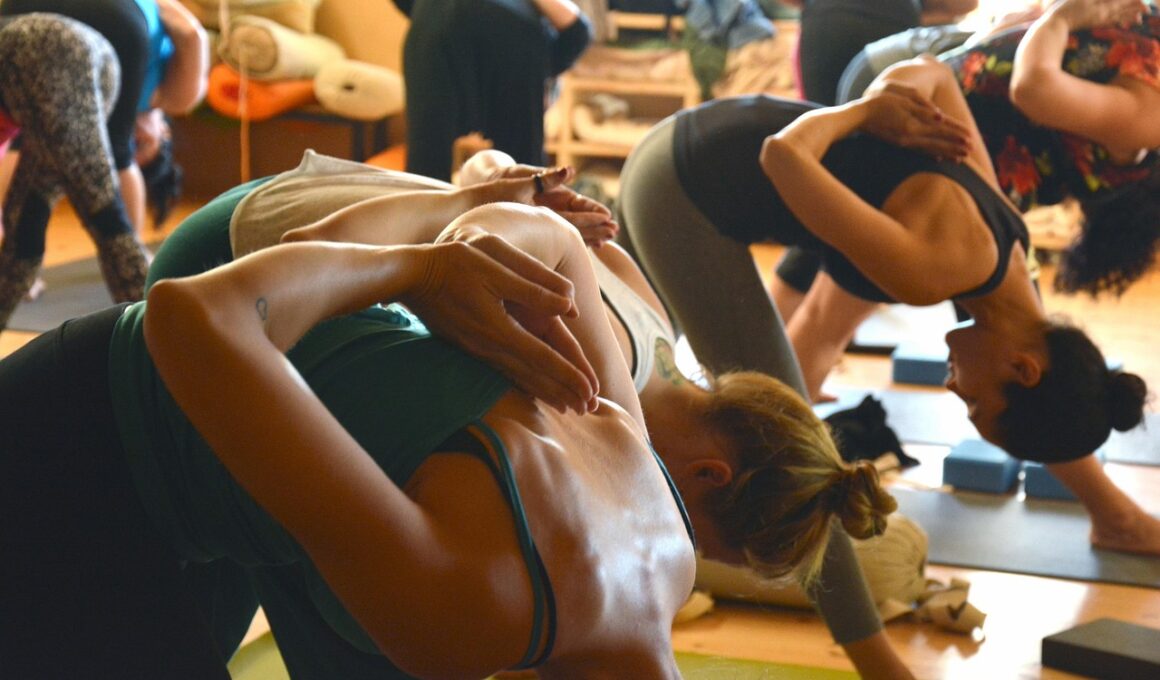Adapting Group Workouts for Different Fitness Levels
Group workouts are a fantastic way to build community and stay motivated. In any gym program, adapting group workouts for different fitness levels contributes significantly to participant success. When you set up these classes, consider the diverse range of abilities in attendance, as each person may have varying goals, fitness levels, and experiences. Therefore, as an instructor, it’s crucial to offer modifications for exercises and allow participants to choose their intensity. This flexibility can make the difference between someone feeling overwhelmed and someone feeling empowered. Instead of a one-size-fits-all approach, you might consider designing three levels for your workouts: beginner, intermediate, and advanced. One simple technique is to demonstrate an exercise and then explain modifications for each level, thus encouraging each participant to work within their own capabilities. Highlighting personal progress and celebrating achievements, regardless of how small, is another way an instructor can keep participants motivated and engaged. Such adjustments not only enhance safety but also promote a sense of inclusivity in the workout environment, providing everyone with the opportunity to progress at their own pace, ultimately leading to greater success and satisfaction.
Ensure that your gym workout group classes can be adapted easily to various fitness levels, fostering an inclusive environment. Start by assessing the group’s baseline fitness level through informal surveys or fitness assessments. This initial step can help tailor workouts more effectively to meet participants’ needs. For example, if you know beforehand that most individuals are at a beginner level, you can plan a class focusing on the fundamentals of movements, kinesthetic awareness, and stability. As the class progresses and attendance changes, keep adapting the sessions to maintain interest and challenge for returning members. Introducing new equipment like resistance bands or dumbbells can also keep workouts fresh without compromising safety or effectiveness. Remember to communicate the purpose of each exercise clearly; encourage open dialogue about participants’ experiences during the session. Incorporate functional movements that mimic daily life activities, allowing for broad appeal and utility in the workouts. This diversity not only benefits those at the basics but regularly challenges more experienced individuals, allowing them to improve on strength and endurance over time. Balancing intensity, complexity, and adjustments will ensure everyone can join and feel accomplished in their fitness journey.
Creating Diverse and Engaging Classes
Creating diverse and engaging group classes takes a bit of effort but pays off during workouts. Mixing various exercise formats, such as cardio, strength, and flexibility, allows you to reach a wider range of fitness levels. For instance, during a circuit workout, ensure there are multiple stations catering to different capabilities. This approach allows participants to choose activities that best match their current fitness level while still enjoying group interaction. Another excellent way to adapt workouts is by offering options for both high and low-impact variations of exercises. Providing a balance of intensity can cater to everyone from beginners to seasoned athletes, allowing them to push their limits as they feel comfortable. You might also consider incorporating challenges into your sessions, such as partner workouts, where individuals can motivate and assist each other to perform exercises safely. Acknowledging the participants’ efforts encourages a positive environment. Combining fun elements with effective routines ensures classes remain lively and engaging. Remember, the goal is to create a space where every participant feels valued and can experience personal growth. With this in mind, your group workout classes can easily accommodate everyone’s needs.
Flexibility in class scheduling is essential when trying to meet varying fitness levels. Offering multiple class times throughout the week can attract more participants and allow for consistent attendance. If a participant can only come once a week, ensure that the class structure allows them to pick up from previous sessions without feeling lost or uninformed. This consistency helps embed skills and knowledge to facilitate continuous progress, which is particularly beneficial in group settings. Consider also varying the themes of classes; for example, focus one week on strength training while the next emphasizes cardio conditioning. This variation keeps classes fresh and participants motivated. Encourage social interaction both inside and outside of classes, such as organizing fitness challenges or community events to further foster relationships amongst your participants. Such opportunities help create a supportive environment, making individuals feel connected and thus more likely to return. Motivation can spread easily in a supportive community, leading to overall growth in individual fitness levels. Providing resources such as nutritional guidance and exercise calendars might further assist members in creating their fitness plans, ultimately helping them achieve personal success over time.
Safety and Injury Prevention
Safety is a vital aspect of any group workout, especially when addressing multiple fitness levels. As an instructor, you should prioritize strategies to prevent injuries by teaching proper form and technique for each exercise. Begin with thorough warm-ups and cool-down sessions, as they significantly decrease the risk of injury. When performing challenging exercises, promote using the correct weights and modifications tailored to participants’ abilities. Be vigilant and attentive to your group; watch for signs of fatigue or improper form. If you notice a participant struggling, don’t hesitate to offer guidance or alternative exercises more suitable for their current level. This proactive approach promotes safety and builds a positive atmosphere of trust. Regularly remind participants about the importance of listening to their bodies and not overexerting themselves. Maintaining open lines of communication is also critical; encourage members to voice concerns or questions about any discomfort they experience. By building trust within the group, participants may feel more comfortable sharing their limitations or asking for help. Ultimately, this commitment to safety enhances the overall class experience, ensuring that each participant can engage fully without unnecessary risk.
Measuring success in group workouts can be subjective, as each individual has distinct goals and milestones. As an instructor, it’s important to foster a culture of personal achievement, rather than competition. Having participants track their progress over time through journaling or fitness apps is one method to encourage growth. Regularly highlight their progress during classes, whether that’s lifting a heavier weight, completing a longer duration of exercise, or successfully performing a challenging movement. Holding monthly fitness assessments can also provide accountability and motivation for the group, allowing everyone to witness each other’s advances. Foster an environment where individuals celebrate each other’s victories, regardless of size. This camaraderie contributes greatly to participants’ motivation to continually push their limits, achieving personal goals collectively rather than singularly. Furthermore, offering small incentives, such as certificates or gym merchandise, for achieving specific objectives can boost motivation and maintain engagement within the group. Building on the successes, both big and small, will ensure that your group workouts remain an enjoyable and valuable experience, promoting long-term commitment to fitness and well-being in every participant.
Conclusion
In conclusion, adapting group workouts for different fitness levels is crucial for maintaining a successful and inclusive exercise environment. By implementing various strategies, from creating diverse class formats to ensuring safety and tracking progress, you can foster a supportive atmosphere. Ensuring each participant feels represented in their fitness journey contributes significantly to their overall engagement and motivation. Remember to emphasize modifications, encourage peer support, and continuously adapt activities based on the group’s needs. As an instructor, take the responsibility to lead by example in promoting a positive mindset. Group workouts can transform individuals’ health and well-being, fostering friendships and community ties. By tailoring your approach, you empower individuals to reach their full potential while enjoying the camaraderie that group exercise offers. Ultimately, providing options suited for different fitness levels makes the space welcoming for everyone to participate. The success of your program hinges on understanding participants’ unique needs and capacities, paving the way for sustainable fitness habits that last long after they leave the gym. As fitness trends evolve, continue to educate yourself, keeping the classes engaging and beneficial for all. Balancing all of these elements will create an enriching experience.


